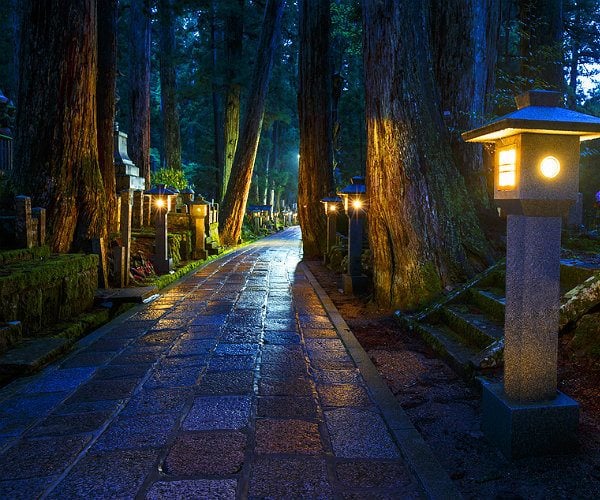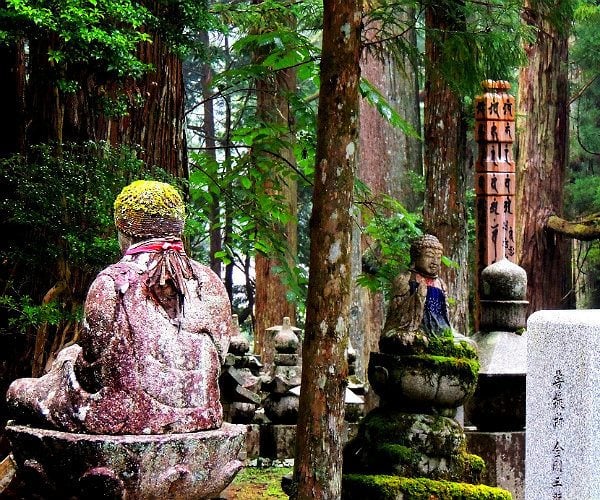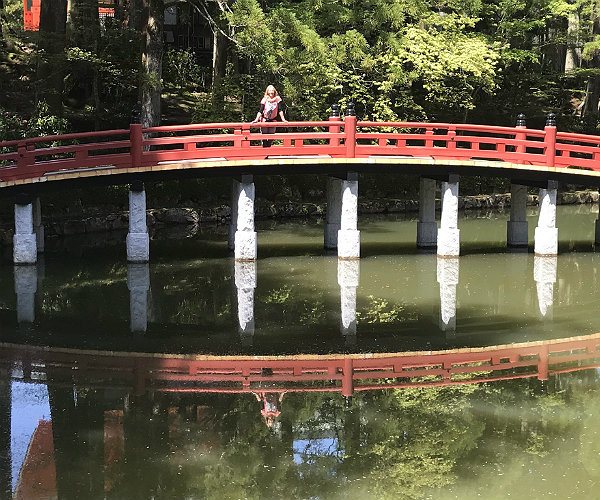Discover the most sacred place in Japan
The last of the 15 countries we visited in our 10 month adventure was Japan and specifically the village of Koyasan on Mount Koya, the most sacred place in Japan.
It is also remote, so after four hours of travel by subway, local trains, the wonderful bullet train, the Nankai Electric Railway, a bus and a cable car we arrived at our temple lodgings known as a Shukubo. The shaven headed monks greeted us warmly with lots of bowing and, new footwear allocated, showed us to a surprisingly comfortable and spacious ryokan room.

One of the monks, Obu a thick set young man – do monks work out? – invited us on a night walk around Okunoin Cemetery. He offered to take us to the cemetery’s mausoleum of Kobo Daishi the monument that makes this area the most sacred part of the most sacred place in Japan and the reason there are 48 temples and monasteries in the small village.

Kobo Daishi studied Shingon Buddhism in China and brought it back to Japan when his master died, he was granted use of Koyasan by Emperor Saga in 816 AD. Obu narrated the story as we walked through the forest of the extensive cemetery towards the mausoleum. Kobo Daishi was led to the area by two dogs, one black one white, representing the gods, he identified Koyasan as the centre to preach Esoteric Buddhism and started to erect temples.

One day he went to meditate as he always did, but for no apparent reason he didn’t stop. Some years later a monk found him still meditating, the monk cut his hair and beard and left him to continue meditating, never to be visited or seen again.
‘We believe,’ said Obu, ‘that he entered eternal meditation and is still there meditating today, over a thousand years later.’
The cemetery was an extraordinary place, over 200,000 ornate and often huge tombstones littered the landscape amongst towering cedar trees several hundred years old. As we walked the two kilometre path through the cemetery to the still meditating Kobo Daishi, Helene asked what lay beneath the tombstones.

‘Perhaps another two or three hundred thousand graves,’ said Obu, ‘people of all classes and all religions have been buried here, providing they believe, they can have a place.’
‘That must make it awfully busy below ground,’ I said.
‘Not really,’ replied Obu, ‘we only bury the throat.’ Now, this was a startling piece of news and clearly prompted the next question.
‘The rest of the bones are with the family of the deceased,’ explained Obu.
The Adams Apple, that apparently looks like a sitting Buddha, is removed and is the only body part buried under the tombstone. Helene, who knows about these things, explained that it is the air from the chest going through the hyoid that gives each person their unique sound, so perhaps the hyoid is removed to allow the soul to communicate in the afterlife. Could well be, we all agreed.

We returned the following morning, after an early start for meditation, attendance at the monk’s daily fire ceremony and a vegetarian breakfast. It was even more spectacular in the brightness of the morning and despite a busier path through the cemetery it was as peaceful and serene as the night before. Any sound seemed to be absorbed by the giant ancient trees creating the most tranquil and calm atmosphere as we strolled to visit the meditating Kobo again. The thousands of tombstones, some covered in hundreds of years of lichen and others gleaming in their newness were an awe inspiring sight.

In the daylight, the entrance to his resting place was remarkable, beautifully embellished with flickering candles and red paper lanterns waving in the cool breeze, and tall gold sculptured lotus flowers shining brightly in the sun either side of the ornate entrance to his tomb.
We spent all morning in the calmness of the forest cemetery but that was okay, it is a spiritual place where time stands still somehow. We strolled around some of the temples Kobo Daishi had built a thousand years ago and picnicked under a blossom tree in an ornamental garden with a classic Japanese arched red bridge.

It was a special visit and a privilege to share such an exceptional experience.
David Moore is Author of ‘Turning Left Around the World’. Published by Mirador and available from Amazon, it is an entertaining account of David and his wife’s travel adventures – often intriguing, frequently funny and occasionally tragic.
If you would like to be a guest blogger on A Luxury Travel Blog in order to raise your profile, please contact us.
Did you enjoy this article?
Receive similar content direct to your inbox.


“Do monks work out?”
What a great title for a book or a movie!
Ha! thanks John…
The actual title of the book is ‘Turning Left Around the World’ so maybe the sequel!
Regards
David
Oh my goodness! That bit also made me laugh and think about monks working out. Maybe they do tai chi or some form of martial arts as their workout? Or probably, if movies are to be believed all the time, cleaning the temples and yard work and then meditation is their exercise. Just look at how vast the temples are.
What a fascinating piece … somehow the spiritual aura has made it into my kitchen as I have my coffee and toast.
I am keen on a little meditation but “eternal meditation”? Surely that’s a bit OTT???
Thanks Claire, I’m glad it touched you as much as it did with Helene and me…
And I agree with eternal meditation being a bit OTT. But it is a very spiritual place where Kobo Daishi is still meditating – unfortunately no photography is allowed, so you’ll have to visit!
Happy travels
David
I always feel a little ambivalent about these spiritual places. I don’t know whether I’m intruding or not. Do they want me there to understand their worship and perhaps become a believer? Or would the worship be better without me thee? I’d hate to be a distraction.
Then again it is such a privilege to be there. So many of us live in a spiritual void and it is a goosebumps moment if you just get a fraction of what they are feeling.
Unfortunately we live in a social media world where we are obsessed with capturing everything digitally for Facebook and Instagram. I’ve been to some spiritual spots where to start with I’ve almost been offended when told that I can’t take photos. Some serious bloggers have just walked away. It is almost as if “I can’t Instagram it I don’t want to be here.” Fortunately, you got the message across without the visuals. There’s a world that still exists beyond social media.
Hi Dave
I completely agree with you…
Drones over Machu Picchu, selfies on the Great Wall of China, flashes at the Terracotta Army and even video at the Killing Fields, we saw it all – it was very disappointing.
Sometimes the poor behaviour of the tourist is inexcusable.
The worst we saw was people climbing Ayers Rock before it is finally closed next year. The question is this; are these places to conquer or to connect with?
Regards
David